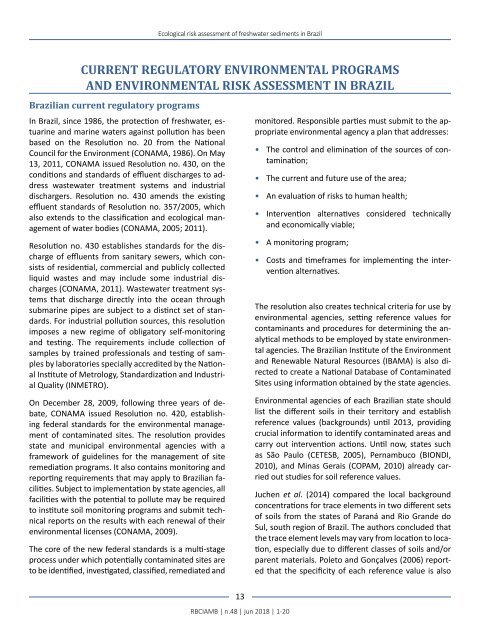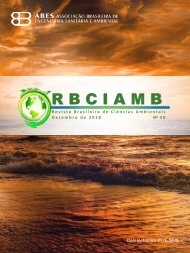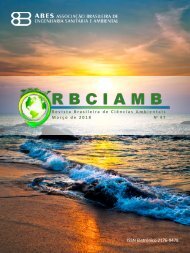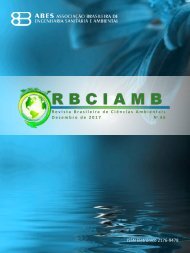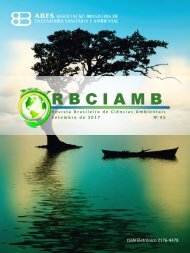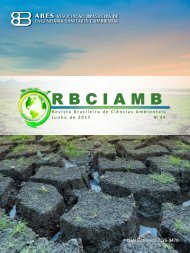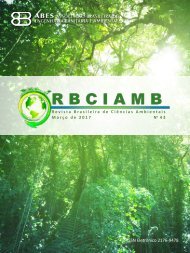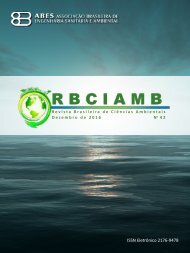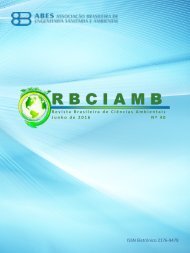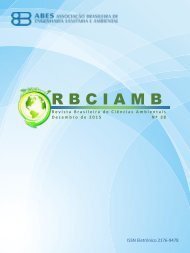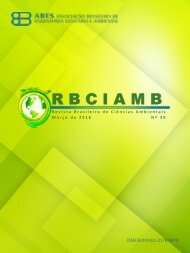Edição 48 RBCIAMB
Create successful ePaper yourself
Turn your PDF publications into a flip-book with our unique Google optimized e-Paper software.
Ecological risk assessment of freshwater sediments in Brazil<br />
CURRENT REGULATORY ENVIRONMENTAL PROGRAMS<br />
AND ENVIRONMENTAL RISK ASSESSMENT IN BRAZIL<br />
Brazilian current regulatory programs<br />
In Brazil, since 1986, the protection of freshwater, estuarine<br />
and marine waters against pollution has been<br />
based on the Resolution no. 20 from the National<br />
Council for the Environment (CONAMA, 1986). On May<br />
13, 2011, CONAMA issued Resolution no. 430, on the<br />
conditions and standards of effluent discharges to address<br />
wastewater treatment systems and industrial<br />
dischargers. Resolution no. 430 amends the existing<br />
effluent standards of Resolution no. 357/2005, which<br />
also extends to the classification and ecological management<br />
of water bodies (CONAMA, 2005; 2011).<br />
Resolution no. 430 establishes standards for the discharge<br />
of effluents from sanitary sewers, which consists<br />
of residential, commercial and publicly collected<br />
liquid wastes and may include some industrial discharges<br />
(CONAMA, 2011). Wastewater treatment systems<br />
that discharge directly into the ocean through<br />
submarine pipes are subject to a distinct set of standards.<br />
For industrial pollution sources, this resolution<br />
imposes a new regime of obligatory self-monitoring<br />
and testing. The requirements include collection of<br />
samples by trained professionals and testing of samples<br />
by laboratories specially accredited by the National<br />
Institute of Metrology, Standardization and Industrial<br />
Quality (INMETRO).<br />
On December 28, 2009, following three years of debate,<br />
CONAMA issued Resolution no. 420, establishing<br />
federal standards for the environmental management<br />
of contaminated sites. The resolution provides<br />
state and municipal environmental agencies with a<br />
framework of guidelines for the management of site<br />
remediation programs. It also contains monitoring and<br />
reporting requirements that may apply to Brazilian facilities.<br />
Subject to implementation by state agencies, all<br />
facilities with the potential to pollute may be required<br />
to institute soil monitoring programs and submit technical<br />
reports on the results with each renewal of their<br />
environmental licenses (CONAMA, 2009).<br />
The core of the new federal standards is a multi-stage<br />
process under which potentially contaminated sites are<br />
to be identified, investigated, classified, remediated and<br />
monitored. Responsible parties must submit to the appropriate<br />
environmental agency a plan that addresses:<br />
• The control and elimination of the sources of contamination;<br />
• The current and future use of the area;<br />
• An evaluation of risks to human health;<br />
• Intervention alternatives considered technically<br />
and economically viable;<br />
• A monitoring program;<br />
• Costs and timeframes for implementing the intervention<br />
alternatives.<br />
The resolution also creates technical criteria for use by<br />
environmental agencies, setting reference values for<br />
contaminants and procedures for determining the analytical<br />
methods to be employed by state environmental<br />
agencies. The Brazilian Institute of the Environment<br />
and Renewable Natural Resources (IBAMA) is also directed<br />
to create a National Database of Contaminated<br />
Sites using information obtained by the state agencies.<br />
Environmental agencies of each Brazilian state should<br />
list the different soils in their territory and establish<br />
reference values (backgrounds) until 2013, providing<br />
crucial information to identify contaminated areas and<br />
carry out intervention actions. Until now, states such<br />
as São Paulo (CETESB, 2005), Pernambuco (BIONDI,<br />
2010), and Minas Gerais (COPAM, 2010) already carried<br />
out studies for soil reference values.<br />
Juchen et al. (2014) compared the local background<br />
concentrations for trace elements in two different sets<br />
of soils from the states of Paraná and Rio Grande do<br />
Sul, south region of Brazil. The authors concluded that<br />
the trace element levels may vary from location to location,<br />
especially due to different classes of soils and/or<br />
parent materials. Poleto and Gonçalves (2006) reported<br />
that the specificity of each reference value is also<br />
13<br />
<strong>RBCIAMB</strong> | n.<strong>48</strong> | jun 2018 | 1-20


